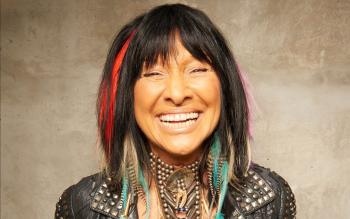Image Caption
Summary
Local Journalism Initiative Reporter
Windspeaker.com
Buffy Sainte-Marie has been in the public eye for six decades, a strong voice and smiling face, unashamedly telling the story of the resilience of Indigenous people through her songs, writing and art.
Now, in a five-episode podcast launching on National Indigenous Peoples Day on June 21, CBC Podcasts is bringing listeners the singer/songwriter’s own story with Buffy.
“To understand Buffy’s story, you have to understand the Indigenous experience,” says podcast host Falen Johnson.
Mohawk and Tuscarora (Bear Clan) from Six Nations of the Grand River territory, Johnson is also the co-host of CBC Podcasts’ The Secret Life of Canada with Leah Simone Bowen. She guest-hosted CBC Radio’s UNRESERVED for the 2020/21 season. Johnson is a playwright, a writer and was named one of Maclean’s 20 to watch in 2020.
When approached by CBC to host this podcast, she says a question the producing team asked her was what does Sainte-Marie’s story mean to this moment that we’re in? Johnson’s response was: ‘What moment?’
“Because this moment is not different from any other moment for me. Before the graves of children, it was the inquiry into missing and murdered Indigenous women and girls, and before that it was the Truth and Reconciliation Commission, and before that it was Burnt Church, and before that it was Ipperwash, and before that it was the Oka Crisis.
“There is no moment for Indigenous people. I don’t feel like I'm in a moment. I feel I’m in a life and these are the cards I've been dealt, and I can decide how to play them.”
Instead, the question Johnson asked herself when preparing to interview Sainte-Marie is what it means to be a public-facing Indigenous woman.
“That was the question for me going into this. How do you handle the responsibility and not compromise your values, continue to speak your mind and also push the bar forward?” thought Johnson. This is what Sainte-Marie has done for Indigenous people across the world.
“How do you remain positive, unjaded, open-hearted, kind and with boundless energy? As much as I want to be like Buffy, I don’t know if anyone ever could because she just feels like a special kind of unicorn creature.”
From 1964, Sainte-Marie was advocating for Indigenous people’s rights, beginning with her first album It’s My Way! Sainte-Marie sang of genocide in the song “Now That the Buffalo’s Gone.” Even now it’s a struggle to have people accept the term genocide in regards to Canadian policies and energies to destroy Indigenous peoples, Johnson says, but Sainte-Marie was “fearlessly herself.”
Sainte-Marie spoke openly about addiction as well. Johnson says she ordered vintage magazines from Etsy and from eBay to show Sainte-Marie her earliest interviews.
“I asked: ‘Do you remember this? I can’t believe you were able to talk about being addicted to codeine in 1965 and to not be afraid to, because even now as Indigenous people there is a brush we are painted with in terms of addiction and substance’.”
In 1965 she said ‘I got addicted to codeine because a doctor intentionally overprescribed me. And I’m saying that here so that other people know.’
As an 81-year-old, Saint-Marie has been telling her story for many years and, as Johnson surmises, is comfortable in its telling. But part of the purpose of this podcast was to delve a little deeper and find out what might have inspired her work.
“She has a narrative, like we all do, so the thing that we wanted to do was match her narrative against the context of what was happening in the world. Because that is where the tension lies. So, if you look at Buffy’s life and what she was doing, she’s writing her albums, she’s on Sesame Street, she’s being blacklisted, she’s writing the first album to be delivered over a modem. But what was happening in the world at that time?”
The podcast covers the multi-faceted life of Sainte-Marie, the genres she’s been a part of—and sometimes created—and the strength and resilience she has exhibited.
“You can’t pin down one style. You can’t pin down one sound. She’s fearless in terms of her creativity,” Johnson says.
“I think sometimes it’s easy to become hindered by success, like ‘this worked so this is what I’m going to do’, but that’s just never been the way that she’s operated. She was in the folk scene in the ‘60s and hanging around Greenwich Village with Bob Dylan and helping Joni Mitchell get her start. Hanging out with all those folkies, which was a pretty misogynistic scene at times too.”
After that? She stepped away from her folk roots and entered into electronic music in 1969, pushing her vocals through a synthesizer before that was common. Sainte-Marie played country music, rock, sampled powwow in disco, and co-wrote an Academy Award winning song.
Johnson hopes this will cause listeners to ask the question what it means to see yourself.
“For an Indigenous person to imagine a future, that future can only sometimes be understood when you can see yourself. When you can see that someone has lit a path in front of you and that there is a possibility for you to pick up a guitar, play the piano, go be a movie star, write a book, write poetry, make a podcast, be a broadcaster, be a journalist, to be all of the things. Because if we don't see those examples, it’s so hard to imagine our futures.”
Podcast episodes will be released weekly beginning June 21 and can be listened to at https://www.cbc.ca/listen/cbc-podcasts/1064-buffy.
Local Journalism Initiative Reporters are supported by a financial contribution made by the Government of Canada.

